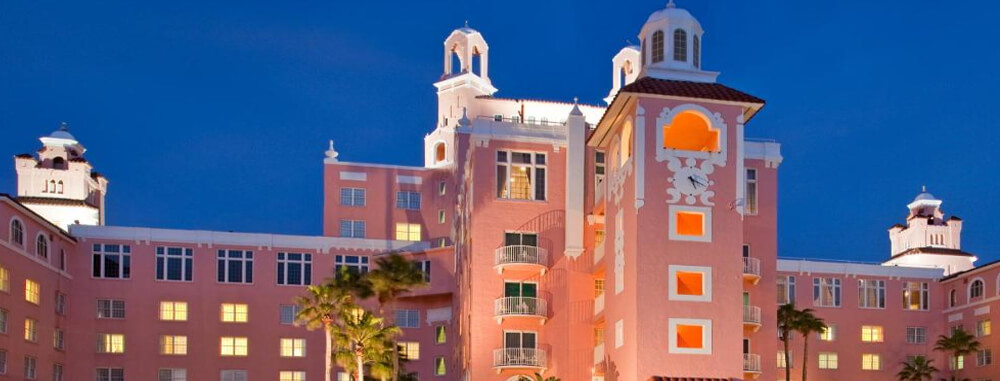Pink Castle on St. Pete’s Beach in Florida Haunted by Lovers
The tropical oceanfront resort is a historic icon built on a romantic dream with rumors that the original owner and his true love still wander the romantic property.
Don CeSar Hotel on St. Pete’s Beach in Florida is a pink beachfront icon with a romantic history. Don CeSar was built by an enterprising man, Thomas Rowe. When Rowe was a young man he fell in love with a woman named Lucinda. People report seeing the ghosts of the lovers holding hands and walking through the pink hotel to this day.
Thomas Rowe and Lucinda: Lovers by the Fountain
Rowe was a young man when he studied in Europe and romanced a young lady named Lucinda. The couple would meet by a beautiful courtyard fountain. Lucinda’s parents did not approve of Rowe and put an end to the relationship. Brokenhearted, Rowe returned to America.
Rowe sent love letters to Lucinda, which were returned, unopened. Sadly, Lucinda died young. She wrote Rowe a note on her deathbed: “Time is infinite. I wait for you by our fountain…to share our timeless love, our destiny is time.
When Rowe built the Don CeSar in 1924, he included a fountain that was a replica of their rendezvous.
Employees at the Don CeSar tell tales of seeing a couple who appear walking hand-in-hand. A gentleman is a dapper man in a white suit and Panama hat. The young lady is a dark-haired beauty. matching the descriptions of Thomas Rowe and his beloved Lucinda. The attractive couple walks through the hotel and disappears.
Thomas Rowe’s Pink Castle on St. Pete’s Beach, FL.
The Don CeSar was Thomas Rowe’s dream. Rowe’s health was failing when he migrated to Florida and began building a “pink castle”. Rowe purchased 80 acres on a narrow strip of land known as St. Pete Beach. Rowe transported building materials on a barge.
The Don Cesar was designed to emulate the pink Royal Hawaiian Hotel on Waikiki Beach. Hawaii. Thomas Rowe had made a fortune and spared no expense in creating this cotton candy pink vision with Mediterranean and Moorish architectural motifs.Inside were ornate marble fountains, lofty ceilings and rich furnishings. Most guest rooms enjoyed views of the Gulf of Mexico or Boca Ciega Bay. Don Cesar, named for a character in a light opera named Maritiana, was a landmark that became a maritime navigational aid.
During the Roaring ’20s, high society flocked to the pink beachfront tropical getaway. Rich and famous guests. included: FDR, F. Scott Fitzgerald, Clarence Darrow, Lou Gehrig and Al Capone.
The depression years of the 1930s were hard on Don CeSar. The grand hotel was helped through the Great Depression by The New York Yankees, who signed a three-year spring training contract in 1931,
According to Rowe’s employees, he considered Don CeSar his home. Rowe would sit at the top of the lobby stairs surveying each guest as they registered. Guests who did not meet his standards would be asked to leave.
Rowe had written, but not signed, a will leaving the “pink lady” to his loyal family of employees. Rowe was hospitalized unexpectedly in 1940. His lawyer rushed to the hospital emergency room with the new will to be signed, but hospital nurses refused to witness the signature due to Rowe’s condition.
Rowe had been married for 30 years, but the couple was estranged. His estranged wife became his widow and inherited the property. Without Rowe, Don CeSar lost much of its charm and personality. Don CeSar was lost because of back taxes.
Don CeSar a government building
During World War II, the Don CeSar was a convalescent center for World War II airmen. Celebrities continued to visit the beachfront property to entertain wounded soldiers and boost morale. After the war, the beautiful building was stripped of luxurious appointments. turned into a veteran’s administration building.
The beautiful fountain in the lobby, a replica European fountain that Thomas Rose and Lucinda would meet at was torn out.
An appalled worker wrote and sealed a letter into the fountain, which was discovered in 1973, 25 years later, and published in the St. Petersburg Times,
“At this spot in the center of the spacious Don CeSar stood a fish pond covered with imported tile. The manager, Mr. J,H.F. Dikensheets, decided that the fish pool was unsightly and in the way of pedestrian traffic, so it must be destroyed. During the Heyday of this hotel, this fish pool was a spot of beauty sitting in the center of this spacious lobby. It is with much regret that Mr. S.F. Kuban, head carpenter, upon instructions of Mr. W.D. Goodale, superintendent of the building, demolished this pool. If this letter should be found, it is hoped it can be published in a newspaper.”
The government abandoned the once-grand building in 1967 because expensive repairs were needed. Don CeSar became an eyesore on the beach, slated for demolition until a preservation group came to the rescue.
Don CeSar Again a Proud Beach Front Hotel
Proud Don CeSar reopened in 1973. The demolished lobby fountain was replaced by a replica fountain.
The Don CeSar celebrated its 75th anniversary in 2003. Don CeSar is on the National Register of Historic Places and National Trust of the Historic Hotels of America. The Loews Don CeSar is a AAA Four Diamond Resort.
If the legends are to believed, the ghosts of Thomas Rowe and his beloved Lucinda are together wandering hand-in-hand through the grand hotel and once again are enjoying their romantic fountain.
Resources:
Don CeSar Hotel
Historic Hotels of America
